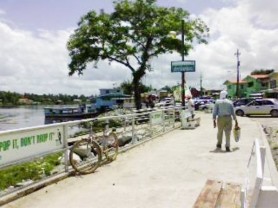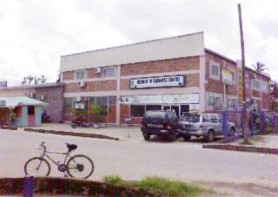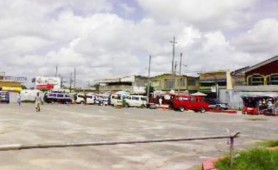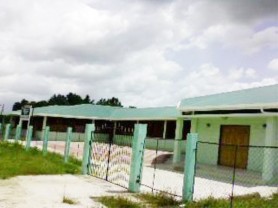– few permanent jobs created
Weeks before its scheduled closure, the Linden Economic Advancement Programme (LEAP) is still beset by the criticism that it failed in its objective to create jobs in the seven years of its existence.

The $2.2 billion LEAP had as its mandate, diversifying the permanent job market in Linden from bauxite mining. However, several community leaders told Stabroek News that although the programme did create a number of jobs they were not permanent and that infrastructural projects and technical assistance were only a secondary part of the programme; though the community will continue to gain from the infrastructural works established.
Meanwhile, the new entity that was set to take over from June 30 is yet to publicise its operational strategy. This newspaper also understands that the entity will no longer be called the Guyana Enter-prise Corporation, though a new title has not been publicised.
Benefits
“I am in a new incubator where the rent is reasonable…,” craft entrepreneur Irene Bacchus-Holder said of her space at the multi-million dollar industrial incubator at Kara Kara. The incubator shares the old Guyana Stores building at Kara Kara with the Toucan Connection call centre, which LEAP touts as one of its investment projects. Toucan employs close to 100 persons and its investment was put at US$500,000 back in 2007.

Bacchus-Holder said she has also benefited from training sessions and from expert advice through consultants, with the latest such assistance as recent as January. The woman said she has gained from LEAP’s intervention; opining that it would have taken her much longer to become as established as she now is and at additional cost. She has recently reduced her staff from five to two, because of the economic downturn. “[I] probably would have to build something,” Bacchus-Holder said about acquiring a work station.
Asked whether she believes the community has gained from LEAP’s operations, Bacchus-Holder quickly said, “of course” though she concedes that things could have been done more “in-depth”. She said too that Linden has benefited in ways other communities have not, through consultancies, assistance in business plan preparation, administration and from technology.
Jobs versus
infrastructural projects
No one can deny that Linden has seen its fair share of infrastructural projects during the seven years of LEAP’s operations. There has been the $40 million-plus Region Ten Business Centre that incubated over six start-up businesses (six small businesses rent spots outside the centre); the $100 million River Front project; the $43.9 million Egbert Benjamin Exhibition and Conference Centre at Mackenzie (also known as the Bandstand project) and several road projects costing hundreds of millions of dollars including (at Moblissa, Speightland, Haimara – at the old aluminum plant, a section of the Ituni/Linden road and in West Watooka).
Assistance had also been given to establish several organisations, studies and even multi-

million dollar bus parks and a demonstration farm at Moblissa leading several Linden residents to question whether that had been the programme’s intention.
“Was that the original objective?” businessman Dunstan Barrow asked. A former CEO of the bauxite company Guymine, Barrow said the declining fortunes of the bauxite industry led to a drop in the number of available jobs and LEAP was developed by the European Commission (EC) as a system of “familiarization intervention” to try and diversify the economy from bauxite and to create other industries to offer employment opportunities.
He said the proof that jobs have been created lies in whether or not the disposable income overall, has increased or improved. The businessman noted that with the current levels of unemployment in Linden he could not say if the programme had achieved its goal.
“Where are the jobs?” he asked, noting that with LEAP closing he was concerned about those persons in the community left without jobs.
Barrow said too the community will gain from the infrastructural work LEAP had done, but

he said that Lichas Hall which LEAP helped to upgrade should be used by entities like schools, free of charge. The Mackenzie High School, he said, had requested to host its graduation exercise at Lichas Hall and was initially told to pay $35,000. A day before the convocation was held on June 25, it was told to pay $20,000, but the school still could not afford the sum and had to resort to the school lawns. Barrow believes that regardless of Lichas Hall’s need to sustain itself certain occasions should get a “free ride,” and that events like these “should be budgeted for.” He said the children of the community would have had parents and grandparents who contributed to the building of Lichas Hall since company workers had money deducted from their pay cheques toward construction in the early days of the bauxite industry. “They can’t bring that argument,” he said, regarding the demand for a fee.
Meanwhile, Linden Chambers of Commerce, Industry and Development President Leonard Forde said LEAP did not accomplish fully what it had set out to do. He opined that it made a number of false starts and was not as effective as it should have been because of the delayed release of money to the Linden Economic Advance-ment Fund (LEAF). Forde said job-creation is related to vertical integration making opportunities available to businesses and giving people opportunities to produce and create employment. He believes too that it has created some jobs but added that some projects that should have provided permanent jobs did not thrive.
Forde pointed to the Arawak Leather shoe factory touted by LEAP that did not materialise as a long-term project, even though it was funded by the LEAF. For these reasons, he said he “can’t call it a total success” as when it closed it should have left a thriving community of businesses. Forde said he is still hopeful that an opportunity would be made available to round-off projects still on stream. He also said he hopes that the chamber is adequately represented on the new entity. There was a request for LEAP to continue until 2010, to ensure that all projects are fully wrapped up inclusive of the deferred periods for infrastructural works, since the deferred period must end before contractors receive the full sum of the projects.
Unproductive spending
Businessman and former mayor Stan Smith said from the inception funding was established for LEAP based on documentation and an examination done on the town of Linden but then the project moved to include the entire Region Ten. He believes that the money spent could have been more productively utilized and the town could have benefited much more than it did. “There wasn’t need for so many vehicles,” he said, adding that the salaries were “too high”. He said too sufficient thought was not put into the purpose of buildings like the Bandstand project; opining that a sports hall or a modern boxing gym or cultural centre could have been more beneficial.
The project should have looked at creating hundreds of jobs, Smith said, adding that “I do not think much work was done with this inward investment.” He argued that the town was not better off than it was seven years ago, in terms of a significant improvement in job creation. Smith said too the plan was to diversify from bauxite therefore the jobs created should have been sustainable. He said, for example that many farmers got loans from LEAF but the farms still failed. “I am not happy,” he said.
Smith was also sceptical about the government running the organisation. He posited that this “is not what capitalism is about.
LEAP’s investment stats
In mid 2007 LEAP’s statistics showed that investment in the region was US$18.6 million ($3.7 billion). At the time investment through LEAF was put at US$2.5 million ($517.6 million) in the areas of agriculture, forestry, manufacturing and services. At the end of 2008, when LEAF had received its final tranche, after a three- year delay, this newspaper understands, it had disbursed a total of over $711 million in loans to micro, small and medium size businesses since 2005, after receiving over $464 million in funds. More than half of this sum; $283 million, was said to be repaid, at the end of 2008. (The higher rate of the euro meant that the fund received more than the $400 million it had been initially pegged to receive.)
LEAF clients have been hard-hit by the economic downturn and several have closed or are finding it hard to pay their instalments. LEAF had also had to resort to court proceedings to recoup loans. According to information from LEAP early this year, so far 1.6 million euros of LEAF’s total 1.9 million euros was received from the EC; $465 million and $73.2 million were outstanding owing to the inflated exchange rates for the euro. It is not clear if the remaining sum had been released.
Infrastructure and tourism development under LEAP in 2007 was said to total US$738,213 ($147.6 million). Private sector investment listed by LEAP in mid-2007 included Bai Shan Lin International’s sawmilling venture in Coomacka of US$10 million. This was formerly Karlam South America Timbers Ltd – whose operations were scaled back and its current operational status in terms of employment is not known. There were also at least three other sawmilling operations with investment put at US$3.6 million that were not named.
A livestock farm valued at US$75,000 was also listed at the time though it is not clear if this project is still operational.
An entertainment facility valued at US$125,000, was also listed as an investment in 2007, but that facility closed operations.
Compare Breads, a bakery that opened last year was touted as an investment valued US$500,000, in 2007, even before it opened.
Church’s Chicken, a fast food joint in Mackenzie was listed as an investment valued US$250,000 in 2007.
Other forms of investments came under the separate Guyana Micro Projects Programme (GMPP), a government of Guyana and European Union project LEAP had said. The project had 70% plus funding given to bankable projects geared toward job creation. Funding under the GMPP to Linden projects amounted to US$196,938 in areas of tourism and forestry, by mid 2007. At the time LEAP said that it had created an environment that attracted these businesses.
International Project Manager Kathleen Whalen said early this year with regard to LEAP’s set indicators, “we would have met most of them.” She said too new jobs were created and investors were attracted to the community. She said LEAP’s efforts at attracting international investment were frustrated by the prevailing financial climate. In addition, there was an admission that some things, if done again would have been done differently in the programme.
As it relates to changing the entrepreneurial attitudes of Lindeners, Whalen had posited that, “Linden has made amazing gains on that,” adding that, “you don’t turn around a company town in seven years.” LEAP had set a target of creating 1,700 jobs when it was launched in 2002 and expected that by mid-2007 at least 65% of this target would have been achieved. It is hoped that LEAP and the government will issue a report on the programme, to sum up its accomplishments based on its objectives.
Less than 50%
Chairman of the Interim Management Committee of Linden Orin Gordon, an early proponent of LEAP having sat on the advisory board, said that one thing the programme did was to create more awareness of entrepreneurship and “awaken it within people.” Gordon said that there had been conflicts early on about how it should be run and funded. Initially funding to LEAF, should have been half the total sum of 19.8 million euros, based on an identification study done back in 1998. However, the programme launched at 12 million euros, $2.2 billion, and only a fraction- 1.9 million euros – had been allotted to LEAF and the remainder for LEAP itself for, administration, technical assistance, projects and studies.
Gordon believed that LEAF was going to drive economic growth, since “funding was the biggest impediment to development.” Complicating matters, the loan facility did not get underway until three years later in January 2005 and was abruptly ended in October of the same year amidst allegations of fraud involving its manager GuyFlag, now Caricom Insurance. He said since Linden was predominantly a mining town it would not have been easy to engender an entrepreneurial attitude, but the amount of credit initially slated to be given to LEAF, if it was given, at least 60%-70% of the programme’s goal would have been achieved.
Although the full sum was not disbursed, Gordon said 50% of the programme — jobs and the general purpose of it — could have been achieved, with what was allotted.
But even though he said LEAP has “done quite well,” Gordon acknowledged that it had “not quite [reached] 50%” attainment from an overall standpoint as even more infrastructural projects should have been established. This newspaper understands that all the sums allotted for infrastructure projects have not been expended. Institutional strengthening was done through the Regional Democratic Council, Linden Technical Institute and Commerce chambers but even this, in his view “was not maximized,” since there was limited capacity, in terms of human resources.





